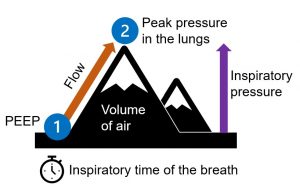Putting It All Together: Volume, Pressure and Time
Imagine you are walking a mountain range. We will use your path across the mountains as an analogy in which each mountain represents a breath that is being delivered by the ventilator.

When you climb up the mountain, that is your inspiration and when you climb down the mountain, that is your expiration. You start walking at the bottom of the mountain. You are not at sea level; you are already at a set altitude before you even start climbing the mountain. This baseline altitude represents the PEEP—the lungs are never empty, even before a breath is delivered.
Once you climb to the top, the peak of the mountain represents the peak pressures experienced in the lungs. The difference in height that you climbed from the start represents the pressure control (Inspiratory pressure). The time it took to reach the top represents the Inspiratory time of the breath. The entire size of the mountain, if you broke down the amount of rock and measured the weight of it, represents the volume of air. The speed of your climb represents the flow.
Review the following visual representation of this analogy carefully:

Advance your understanding in this analogy by deepening your thinking. Consider the following two points:
- Peak heights are a factor of the altitude you start plus how high you climb (PEEP + inspiratory pressure): If you start at a lower altitude (PEEP 5) and walk up a steep mountain (your set pressure is PC 10) you could reach the same peak height (peak pressure), as if you started at a higher altitude (PEEP 8) and walked up a shorter mountain (PC 7).
- The size of the mountain in amount of rock (volume) can still be larger if you climb longer but not as high: a high narrow mountain (high pressure and short inspiratory time) might be less rock mass then a wide, moderately high peak (moderate pressures and long inspiratory time).
Now, consider a few applications to ventilation using this same analogy:
- Volume control (VC): If you want to climb a bigger mountain in the same amount of time, you have to walk faster. In the same way, in the context of volume control, the more volume, the higher the flow.
- Pressure Control (PC): If you climb to a higher peak, the mountain is larger. In the context of pressure control, when a higher pressure is applied, this equates to a bigger volume.
- Itime (IT): If you climb longer at the same speed, but to the same peak altitude, this means that you’re climbing a wider mountain, which is still a bigger mountain. When the Itime is lengthened, at the same flow and to the same peak pressure, this means that you will have higher volume than before.
Media Attributions
- mountain-984083_640 © Free-Photos is licensed under a CC0 (Creative Commons Zero) license
- Mountain analogy infographic © Amanda Robinson is licensed under a CC BY-SA (Attribution ShareAlike) license

